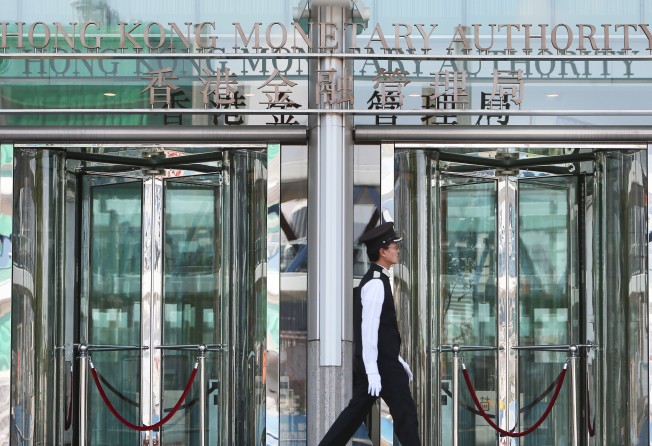
Monetary authority poised to intervene as Hong Kong’s dollar weakens to its lower limit
Hong Kong’s currency weakened close to the lower limit of its trading band, as the city’s de facto central bank says it will step in when it hits 7.85 per US dollar

Hong Kong’s dollar has had its worst week in three months, deteriorating further against the US dollar after the city’s monetary authority (HKMA) cleared the way for the currency to weaken to the lower limit of a trading band before it intervenes in the market to prop it up.
The city’s currency strengthened slightly to 7.8376 per US dollar on Friday, but ended the week 0.1 per cent weaker against the greenback, having deteriorated for six consecutive days.
The local currency, pegged to the US dollar since 1983 at 7.8 per dollar, is supposed to move within a trading band of between 7.7500 and 7.8500. When it breaches the upper or lower limits of the band, the HKMA is mandated to either buy or sell the local currency to bring the exchange rate back into the band.
“We are looking forward to funds flowing from HK dollars into US dollars, causing the HKD exchange rate to reach 7.85 – a level where the HKMA will take action,” the monetary authority’s chief executive Norman Chan Tak-lam said on Thursday in a statement on the HKMA’s website. “This will allow the monetary base to contract gradually, and create an environment conducive to the normalisation of HKD interest rates.”

What’s weighing on the Hong Kong dollar is the carry trade, where investors sell low-yielding assets to invest in high-yielding ones. This has been helped by a 103-basis point difference between Hong Kong and US borrowing costs, the widest gap since 2008, which lures funds to flow from Hong Kong dollars into the greenback.
“We expect the Hong Kong dollar to reach 7.85 at the end of the first quarter,” Standard Chartered Bank wrote in a research report. “As much as HK$40 billion could be withdrawn from the monetary base per month based on historical trends, and we expect the withdrawal of HKD liquidity for the first time since the introduction [of the peg].”
We expect the Hong Kong dollar to reach 7.85 at the end of the first quarter
The Hong Kong dollar is backed by the HK$4 trillion (US$513.5 billion) Exchange Fund, one of the world’s largest currency reserves. The fund, established as an asset war chest for defending the local currency’s value and keeping it within the trading band, also makes investments, earning a record income of HK$252 billion last year.
The last time the HKMA fought a currency war in 1997, overnight interest rates surged to 300 per cent as the monetary authority held back from putting liquidity into the interbank market. The move choked off the supply of Hong Kong dollars to short sellers, allowing the local currency to stabilise.
The decision to let the Hong Kong dollar weaken to activate the liquidity withdrawal underscores the HKMA’s determination to tighten liquidity and push up borrowing costs at a faster pace to manage stability in the financial system and prevent excessive risk-taking.
“It now appears that intervention could be preferred, if the central bank thinks there is a need to remove HKD liquidity on a permanent basis, given that the US Federal Reserve is in a cycle” of raising interest rates, said ANZ Bank’s senior Asia strategist Irene Cheung.